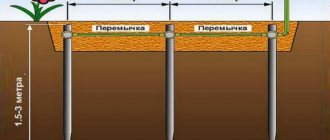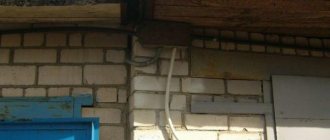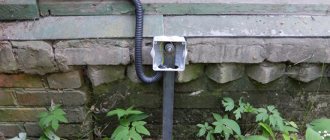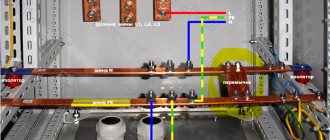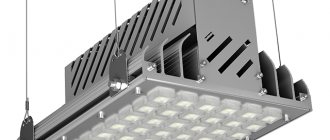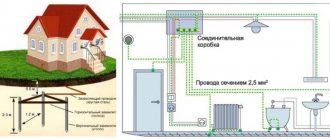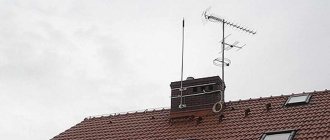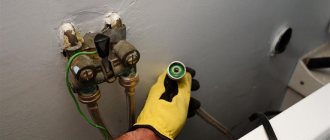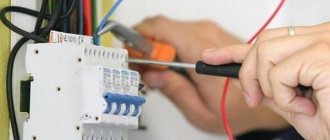The design of modern household electrical appliances requires that they be grounded. To do this, you need a third wire in your home network. In rural areas, the electrical network is predominantly two-wire, consisting of a working zero and a phase. With this and any other power supply system, you can make grounding at your dacha with your own hands.
Separately about the grounding of some units
In a private home there are some powerful devices that consume large amounts of electricity and pose an increased danger.
It is important to properly ground these units to protect yourself and your loved ones.
Gas and electric boiler
The issue of grounding a gas boiler in a private house should be approached with all responsibility. Otherwise, you may not only lose the automation, which is very sensitive to sudden changes in voltage, but also risk your life, since the gas can explode from any spark.
Don't relax if your gas inspector doesn't require you to install an earth electrode. This is not strictly prescribed by the rules. Take care of your own safety without waiting for unpleasant consequences.
Scheme for a gas boiler
For the boiler, you can use a homemade circuit, which we have already discussed, or purchase a ready-made kit.
Related article:
Water heater
The most common mistake in grounding a water heater is connecting it to a phase wire in an outlet. This threatens an emergency phase loss. Only an automatic device can prevent the consequences of such a shutdown, but it is not installed on all units.
It is believed that connecting the grounding contacts to a circuit in the ground leads to premature corrosion of the water heater body, but here the lesser of two evils is chosen. Experts recommend installing a residual current device with the water heater along with the grounding loop.
How to ground a water heater in a private house in the following video:
Watch this video on YouTube
Related article:
Socket
Grounding outlets is a way to protect all other electrical appliances in the house. You should take care of the safety of your home even at the time of laying the wiring. To do this, use a three-core wire, which contains “zero”, “phase” and “ground”. It is very convenient if the wires are braided in different colors; this greatly facilitates installation.
Modern manufacturers produce sockets in which it is difficult to confuse anything. All terminals are clearly marked, so even a beginner can connect the outlet.
How to ground an outlet in a private house in video instructions:
Watch this video on YouTube
The difference between a lightning rod and grounding
Do not confuse grounding with a lightning rod. Despite the fact that they operate on a similar principle, their tasks are different. A lightning rod is needed to receive a discharge from lightning and transmit it through a ground loop isolated from the internal network directly into the ground.
Grounding, in turn, serves to drain current from the internal home network in case of overload. In principle, grounding and lightning rods can have a common external circuit, subject to compliance with safety regulations. By the way, you can buy ready-made lightning protection kits that comply with all the rules and conditions for efficiency and safety.
Choosing a location for installation
Its efficient and safe operation largely depends on the correct location of the circuit arrangement. There are several recommendations on this matter:
- Do not place the ground loop in a place where people or animals are constantly or frequently present. When the insulation breaks down and voltage is discharged into the ground, a person or animal in the immediate vicinity may be harmed. It is better to take measures to fence such an area.
- Some experts recommend placing the contour on the north side of the building. This is explained by the moister, damp conditions in such an area.
- If the soil is too wet and there is a high probability of corrosion of the metal of the circuit, then it is better to make it from large-section steel. The circuit structure can also be coated with special conductive materials that will protect against corrosion but will not impair electrical contact with the ground.
- You should not place the grounding loop close to heat communications. Over-dried soil has a negative effect on the circuit resistance indicator.
- It is prohibited to place the circuit in close proximity to a gas pipeline running in the ground.
- The depth of the circuit must be below the freezing level of the soil, but not less than 0.5 m.
If you follow these recommendations, you can be sure of the correct location and reliable operation of the ground electrode.
Requirements for the resistance of the grounding device.
Grounding for a private home makes sense if the circuit resistance is minimal. In this case (when the human resistance is much greater than the resistance of the circuit), an imperceptible charge will pass through the body, and the remaining potential will go into the ground.
Resistance is determined by the type, quantity and depth of grounding elements, as well as the properties of the soil. Loamy and clayey soils with a moisture content of 20-40% are considered optimal.
To ensure that the grounding device is performing its functions, a resistance measurement is carried out.
Basic grounding schemes
Experts recommend using standard and proven grounding schemes for summer cottages. This is justified by the fact that such schemes have been tested for several years and have already proven their reliability and safety.
The most reliable schemes are considered to be:
A recessed metal contour that is placed around the structure. Often the main material for drainage is classic construction reinforcement
The reinforcement rods are connected to each other by a welded metal busbar. Among summer residents, a scheme for placing three electrodes in the ground, which are connected to each other by a steel strip, is also common. The simplest scheme is to place a very long branch at a significant depth, which should be at least 6 meters. Important! Painting the grounding elements that perform the tapping function worsens the conductivity properties. Fundamental ground electrode
This scheme is very thorough, since it is a closed circuit, which is welded in the form of a metal mesh. Experts recommend laying such a mesh on the bottom row of reinforcement in the foundation. Installation of such grounding is possible only during the construction of the foundation.
Which scheme to choose
Before proceeding directly with the grounding installation, it is necessary to select a scheme according to which the electrodes will be located underground. It is necessary to correctly select the materials from which all structural elements will be made, as well as calculate the dimensions of the electrodes and connecting parts. Grounding parameters are calculated using a special formula, which allows you to accurately select the layout of all protective elements.
When it comes to grounding patterns, a triangle is considered the most effective. It is the three-way circuit that ensures rapid and complete absorption of electricity by the ground, evenly distributing the current over the surface.
If the size of the area does not allow placing a volumetric triangular structure, the electrodes are placed in one line, in a semicircle, or, for example, in a wave. However, most experts agree that the best arrangement of electrodes is considered triangular, since it ensures the fastest and most efficient absorption of current by the ground.
Preparing the required triangle
The installation location of the electrodes is selected so that it is convenient to connect the grounding bus to the distribution panel. But design dimensions are not mandatory. The sides of the triangle can be less than three meters in length, and the depth of driving the pin can be reduced to 2-2.5 meters. The number of electrodes can also be increased if the soil is dense and it is not possible to drive the pins to the designed depth.
After marking the selected location, you can dig a small pit to a depth of up to 1 meter. At the same time, we dig a trench of the same depth for a grounding bus from the circuit to the base of the house. Sometimes, instead of a pit, trenches are dug along the perimeter of the contour being created, which somewhat simplifies the excavation process
You just need to pay attention that their width allows you to freely carry out welding work and driving in electrodes. It is better to cut the edges of the electrodes with which they will go into the ground at an angle and sharpen them with a grinder
Remember that the metal must be unpainted.
We drive the electrodes into the ground with a sledgehammer in the designated places so that they protrude about 200 mm above the surface level. Then we connect them using electric welding with a common busbar made of steel strip. It is better to refrain from using bolted connections - the threaded contact underground will quickly oxidize, and the circuit resistance will increase critically. Now you can lay a bus from the same steel strip to the foundation of the house.
Expert advice
A slight bend must be provided in front of the mounting point on the plinth to compensate for the linear movements of the tire due to temperature changes. The strip should end with a welded bolt with an M10 thread, to which a copper terminal with a ground wire will be attached to the distribution panel.
How to connect the electrodes
In order for grounding to quickly remove current, the electrodes must be connected to each other using metal with low resistance. For this purpose, either steel or non-ferrous metals - aluminum or copper - are used. In this case, it is necessary to correctly calculate the cross-section of the connecting bus, which will ensure the efficiency of the entire system.
Minimum cross-section, depending on material:
- The copper busbar or wire must have a cross-section of at least 10 mm2.
- The aluminum connector cannot be thinner than 16 mm2.
- Steel strip with a cross-section of at least 48 mm2.
It is important to remember that non-ferrous metals, unlike steel, cannot be welded to ordinary iron, and therefore, if copper or aluminum is used as a busbar, threads are cut on the electrodes to secure the strip to the bolts.
Grounding diagram in a private house
As a rule, power supply in private homes is carried out by overhead lines with a TN-C grounding system. In such a system, the neutral of the power source is grounded, and the phase wire L and a combined neutral protective and working wire PEN are connected to the house.
After the house has installed its own grounding loop, it is necessary to connect it to the electrical installations of the house.
- You can do this in two ways:
- convert the TN-C system to the TN-CS grounding system;
- connect the house to the ground loop using the TT system.
Connecting the house to the ground loop using the TN-CS system
As you know, the TN-C grounding system does not provide a separate protective conductor, so we are converting the TN-C system to TN-CS in the house. This is done by dividing the combined neutral working and protective PEN conductor in the electrical panel into two separate ones, working N and protective PE.
And so, two power wires approach your house, phase L and combined PEN. To get a three-wire electrical wiring in the house with separate phase, neutral and protective wires, it is necessary to correctly divide the TN-C system into TN-CS in the incoming electrical panel of the house.
To do this, install a bus in the shield that is metallic connected to the shield; this will be a PE grounding bus; a PEN conductor will be connected to it from the power source side. Next, from the PE bus there is a jumper to the bus of the zero working conductor N; the bus of the zero working conductor must be isolated from the shield. Well, you connect the phase wire to a separate bus, which is also isolated from the switchboard.
After all this, it is necessary to connect the electrical panel to the grounding circuit of the house. This is done using a stranded copper wire, connect one end of the wire to the electrical panel, attach the other end to the grounding conductor using a bolt at the end, which was specially welded for this purpose.
Connecting the house to the ground loop using the TT system
For such a connection, it is not necessary to make any separations of the PEN conductor. Connect the phase wire to a bus isolated from the switchboard. You connect the combined PEN conductor of the power source to a bus that is isolated from the switchboard and in the future consider the PEN to be simply a neutral wire. Then connect the shield housing to the house ground loop.
As can be seen from the diagram, the grounding loop of the house does not have any electrical connection with the PEN conductor. Connecting the ground in this way has several advantages compared to connecting using the TN-CS system.
If the PEN conductor burns out on the power source side, all consumers will be connected to your ground. And this is fraught with many negative consequences. And so your grounding will not have a connection with the PEN conductor, this guarantees zero potential on the body of your electrical appliances.
It often happens that on the neutral conductor, due to an uneven load across the phases (phase imbalance), a voltage appears that can reach values from 5 to 40 V. And when there is a connection between the network neutral and the protective conductor, it can also occur on the housings of your equipment little potential arises. Of course, if such a situation arises, the RCD should trip, but why rely on the RCD. It would be better and more correct not to tempt fate and not lead to such a situation.
From the considered methods of connecting the grounding loop of a house, we can conclude that the TT system in a private house is safer compared to the TN-CS system. The disadvantage of using a CT grounding system is that it is expensive. That is, when using a TT system, protective devices such as RCDs and voltage relays must be installed.
I would also like to note that it is not necessary to make the outline in the form of a triangle. Everything depends on external conditions. You can place horizontal grounding conductors in any order, around a circle or along one line. The main thing is that their number is sufficient to ensure minimal grounding resistance.
Example of memory calculation
As an example, we consider the calculation of the resistance of a single vertical rod (photo on the right). To carry it out
Installation diagram of a single vertical ground electrode
the following data is used:
ρ – soil resistivity (in Ohms per meter);
L – total length of the original rod (in meters);
d – its main standard size (diameter) in meters;
T is the distance from the surface of the earth to the middle of the pin.
If we exclude the influence of factors that determine the spread of current in horizontal elements, the resistance for vertical stakes is calculated as follows:
The required number of rods that guarantees the required conductivity value (without taking into account horizontal components) is determined from the following formula: where Rн is the standard spreading indicator standardized by PTEEP.
Taking into account the previously unconsidered horizontal elements, the formula for determining the number of rods takes on the following form:
where ηв is the load factor of the circuit breaker, taking into account the influence of flow currents of different rods on each other.
Additional information: When two rulers of tinder are placed in parallel, their mutual influence is much stronger.
If their arrangement is excessively “dense,” the complex resistance of the circuit breaker increases noticeably. The conductivity value obtained as a result of the proposed calculations is then rounded up.
The considered calculation method can be fully automated if you use an online calculator for calculating grounding resistance, specially designed for these purposes.
DIY grounding device: step-by-step instructions
If you are asking the question: “how to make grounding at the dacha?”, then to complete this process you will need the following tool:
- a welding machine or inverter for welding rolled metal and bringing the circuit to the foundation of the building;
- an angle grinder (grinder) for cutting metal into specified pieces;
- wrenches for bolts with M12 or M14 nuts;
- bayonet and pick-up shovels for digging and burying trenches;
- a sledgehammer for driving electrodes into the ground;
- a hammer drill for breaking up rocks that may be encountered when digging trenches.
In order to correctly and in accordance with regulatory requirements perform a grounding loop in a private house, we will need the following materials:
- Corner 50x50x5 - 9 m (3 segments of 3 meters each).
- Strip steel 40x4 (metal thickness 4 mm and product width 40 mm) - 12 m in the case of one grounding point connected to the foundation of the building. If you want to make a grounding loop along the entire foundation, add the total perimeter of the building to the specified amount and also take a reserve for trimming.
- Bolt M12 (M14) with 2 washers and 2 nuts.
- Copper ground electrode. A grounding conductor of a 3-core cable or a PV-3 wire with a cross-section of 6–10 mm² can be used.
Once all the necessary materials and tools are available, you can proceed directly to the installation work, which is described in detail in the following chapters.
Selecting a location for installing the ground loop
In most cases, it is recommended to install the ground loop at a distance of 1 m from the foundation of the building in a place where it will be hidden from the human eye and which will be difficult to reach for both people and animals.
Such measures are necessary so that if the insulation in the electrical wiring is damaged, the potential will flow to the ground loop and a step voltage may arise, which can lead to electrical injury.
Excavation work
After a location has been chosen, markings have been made (for a triangle with sides of 3 m), and the location for the strip with bolts to be laid out on the foundation of the building has been determined, you can begin excavation work.
To do this, it is necessary to remove a 30–50 cm layer of earth around the perimeter of a marked triangle with sides of 3 m using a bayonet shovel. This is necessary in order to later weld the strip metal to the ground electrodes without any special difficulties.
It is also worth additionally digging a trench of the same depth to bring the strip to the building and bring it to the facade.
Hammering of grounding conductors
After preparing the trench, you can begin installing the ground loop electrodes. To do this, you must first sharpen the edges of a 50x50x5 corner or round steel with a diameter of 16 (18) mm² using a grinder.
Next, place them at the vertices of the resulting triangle and, using a sledgehammer, hammer them into the ground to a depth of 3 m
It is also important that the upper parts of the grounding conductors (electrodes) are at the level of the dug trench so that a strip can be welded to them
Welding work
After the electrodes are driven to the required depth using a 40x4 mm steel strip, it is necessary to weld the grounding conductors together and bring this strip to the foundation of the building where the grounding conductor of the house, cottage or cottage will be connected.
Where the strip will reach the foundation at a height of 0.3–1 moth of earth, it is necessary to weld an M12 (M14) bolt to which the grounding of the house will be connected in the future.
backfilling
After all welding work has been completed, the resulting trench can be backfilled. However, before this, it is recommended to fill the trench with saline solution in the proportion of 2-3 packs of salt per bucket of water.
Afterwards, the resulting soil must be compacted well.
Checking the ground loop
After completing all the installation work, the question arises: “how to check the grounding in a private house?” Of course, a regular multimeter will not be suitable for these purposes, since it has a very large error.
To perform this activity, the F4103-M1 devices, Fluke 1630, 1620 ER clamps, and so on are suitable.
However, these devices are very expensive, and if you do the grounding at your dacha with your own hands, then to check the circuit, an ordinary 150-200 W light bulb will be enough for you. For this test, you need to connect one terminal of the lamp socket to the phase wire (usually brown) and the second to the ground loop.
If the light bulb shines brightly, everything is fine and the grounding circuit is fully functioning, but if the light bulb shines dimly or does not emit a luminous flux at all, then the circuit is mounted incorrectly and you need to either check the welded joints or install additional electrodes (which happens when the electrical conductivity of the soil is low).
Preparing material and tools
We will assume that we are making a closed triangular grounding circuit, since this is the most popular.
First, let's figure out the material, and based on what it will be, we will prepare the tool.
So, from the material we will need:
1. For vertical grounding stakes you can use: a pipe with a wall thickness of at least 3.5 mm and a diameter of 30 mm, fittings with a diameter of 2-3 cm, a corner 5x5 cm (preferably made of stainless steel). The length of any material must be at least 2 meters.
Before using the blanks, it is recommended to sharpen them in any way convenient for you.
2. Metal strips with a cross-section of 40x4 mm, a length of at least 1.2 meters.
3. The same metal strip as in point 2, but preferably made of stainless steel. Its length will depend on the distance from the place where the grounding stakes are installed to the place where it is inserted into the house.
4. Copper wire for phase conductor with a diameter of 6 mm.
5. Bolts. M8 is recommended.
How to do grounding correctly in the house
As a rule, a TT system is used to supply electricity to a private house; in such a system, the PE grounding wire is connected to the grounding loop, and nowhere else. With such a system, it is necessary to make a high-quality grounding circuit so that in the event of a short circuit to ground, the short circuit current is sufficient to trip the circuit breaker. Let's look at how to do grounding correctly in a private home.
The circuit consists of grounding conductors and metal strapping. Grounding electrodes are made of metal pins 2-3 meters long; they go completely into the ground. These pins and the distribution board in the house are connected by metal strapping. Metal pipes, angles, and rods can be used to make pins. Reinforcement cannot be used, as it rusts faster and loses its grounding properties. It is convenient to connect the pins together with a metal strip. There are fundamentally two ground loop schemes:
- Linear diagram of the grounding circuit, grounding electrodes are laid in a row and connected in series.
- Closed loop circuit, such as triangular and square, in which all the ground pins form a closed circle. This scheme is more reliable and optimal. If the area near the house allows, then use it. The most optimal scheme would be a triangle; the distance between the pins should be the same from 1 m to 1.5 m.
The organization of grounding in a private house can be divided into three stages of work: installing a grounding circuit in the ground, connecting the circuit to the electrical panel and checking the operation of the grounding.
STAGE1
- We mark the area under the contour of the triangle, and dig a trench 70 cm deep in the direction of the building.
- At the corners of the triangle, metal corners or pipes are driven into the ground to a depth below the freezing level, about 2.3 meters. The ends of the pins are driven in so that after filling with soil there is still about 50 cm of soil above them.
- Then these ends are connected by welding with metal strips, thereby forming a closed loop in the form of an isosceles triangle.
- Then a metal strip leading to the house is welded to the contour. At its end, on the wall of the house, we weld a bolt to which the grounding wire from the busbar in the electrical panel will be attached.
- Welding seams are painted with bitumen paint or mastic to protect against corrosion.
- We fill the trench with soil and paint the earth tire that protrudes from the ground to protect it from corrosion.
STAGE2
To connect the earth bus to the panel, it is better to use a yellow copper wire with a cross-section of at least 10 sq. mm.
The copper wire is also attached to the panel with a screw connection to the housing. If the switchboard door is not grounded, ground it with another wire.
Advice! Select in advance the grounding bars in the panel with the required number of holes for different lines, since it is prohibited to attach two wires to one point.
STAGE3
Check the functionality of the completed protective. It is better to carry out such a check once every 3 years, for your safety. The check is carried out with an ohmmeter. It may seem that you can check your circuit by connecting an ordinary light bulb to the phase and circuit and it will light, but this is erroneous due to low power consumption.
The resistance of the ground loop should not be more than 4 ohms. I advise you to invite an electrician and be sure that your ground loop is working correctly.
One solution to all problems - a ready-made grounding kit
Few people think about grounding even before laying the foundation, and not always during the process of pouring it, so most often they choose the modular-pin method. But when using improvised “components” several problems arise:
- Weak contact with the ground - sufficient length of the pins is achieved by connecting with couplings; due to their larger diameter, the pin itself “walks” in the hole and cannot fully work as a conductor.
- Damage to couplings - when driving with a sledgehammer or hammer drill, the couplings become unscrewed or damaged.
- Difficulties with deepening - the soil is different, the harder it is, the more difficult it is to install the rod clearly vertically, or even drive it in at all.
And be that as it may, a specialized grounding kit, developed taking into account the specifics of the application and regulatory requirements, always wins in terms of quality characteristics, ease of installation, and reliability. There is no need to “collectively farm” anything, everything has already been invented and implemented.
The ready-made grounding kit is a set of four one and a half meter galvanized steel rods, which are connected end-to-end without couplings and the use of conductive paste (can be washed out by groundwater over time). Plus, the necessary extras.
Gennady ChebatarevTechnical specialist at OBO Bettermann
The kit includes 20 mm grounding rods with a zinc layer of 130 microns, which exceeds the value of GOST R IEC 62561-2 by 2 times and allows long-term operation of up to 50 years. And:
- tip for deepening rods and passing stones;
- bolt connector with conductor, tip for hammering with a sledge hammer;
- insulating tape, which serves as additional protection against corrosion and is wound around the connector with the conductor;
- detailed instructions for operating the ground electrode.
The kit is completely ready for installation; its cost, compared to the general construction budget and taking into account the efficiency and durability of the resulting grounding device, is quite affordable for all homeowners. Engineering electrical equipment and household appliances cost many times more, and the well-being of household members cannot be measured with any money.
What is a ground loop: definition and device
A grounding loop is a special design made of electrically conductive materials with low electrical resistance, providing instant drainage of electric current to the ground. It consists of 2 interconnected parts - an internal and external system. Their reliable connection is carried out in the input electrical panel.
The design of the external subsystem must ensure the transition of the electrical signal to the ground with its distribution over the area. It is based on several electrodes buried in the ground and connected to each other in a circuit using plates. A bus of sufficient cross-section extends from the plates, which is inserted into the electrical panel, where it is connected to the internal subsystem. Each electrode is a metal pin buried (driven in) to a certain depth.
The internal subsystem is the distribution of the grounding circuit throughout the house. Conductors from the switchboard are routed to sockets, to the housings of powerful electrical devices, and to metal mains (pipes). The individual conductors are combined into a common bus, which is connected to the external circuit bus.
The principle of operation of the ground loop is quite simple. The electric charge accumulated in metal elements (installation housings, pipelines, fittings, etc.) when the insulation of the electrical network conductors is damaged or induced from external sources, rushes through the wires of the internal subsystem, which have low electrical resistance, to the circuit of the external subsystem. It “flows” into the ground through electrodes buried in the ground. In turn, the earth has a huge capacity, which allows it to freely “absorb” such electricity leaks.
What materials cannot be used for grounding
It is not advisable to make electrodes from corrugated reinforcement. It has poor contact with the ground: when driven into the ground, voids are formed. It is forbidden to paint the electrodes: such a surface has poor conductivity.
Do not connect the ground to a steel pipe of an existing central or home water supply or heating system. Underground, they are often heavily covered with rust, and emergency current flows poorly through them. It accumulates on pipes, touching which is fraught with unpleasant consequences.
Grounding device on the street near the house
The installation of a grounding loop in a private house consists of pins driven vertically into the ground, which are tied together with conductors. And this whole structure is connected to the distribution panel in the house. Before making grounding in a private house, you need to prepare the necessary tools and materials.
The tools you will need are shovels, a crowbar, a sledgehammer, a hammer, a welding machine with electrodes, a grinder, and wrenches. From materials:
- metal corner measuring 50x50x5 mm;
- steel strip 40 mm wide and 4 mm thick;
- metal wire rod with a diameter of 8-10 mm.
In purely structural terms, the house grounding loop is an equilateral triangle, into the corners of which metal grounding conductors are driven. This is what a metal corner is used for. The driving depth is 2.5-3.0 m. You can do this yourself with an ordinary sledgehammer. If the soil in the area is hard, then you can first make a deepening with a drill to a depth of 1.5 m, and then finish off the corners with a sledgehammer.
The installation process must begin by marking the size and shape of the ground loop on the ground. After that, a trench up to 60 cm wide is dug around the entire perimeter to make it convenient to carry out welding, and 80-100 cm deep. Grounding conductors are driven in. To ensure that the process of inserting the corners into the ground goes smoothly, it is recommended to sharpen their ends into a cone. There is no need to hammer it in all the way; you want the edges of the pins to remain sticking out above the bottom of the trenches, approximately 20-30 cm.
Now it is necessary to connect the corners with each other using horizontal elements of the ground loop. A metal tape is used for this. The connection is made only by electric welding. There are no bolts that will become corroded underground, which means partial or complete lack of contact, which will lead to ineffective grounding in a country house.
The next stage is connecting the completed circuit to the distribution panel in the house. For this you can use either wire rod or the same metal strip. In the yard, the connecting circuit is drawn in a trench, inside the house along a wall or baseboard. At the end of the conductor that entered the house, an M6 or M8 bolt is welded. A ring of wire responsible for the internal grounding of a private house will be put on it. Fastening is done with a similar nut. Joint insulation may be necessary.
Welding areas must be treated with anti-corrosion compounds. But it is prohibited to paint the entire contour or coat it with any protective compounds. Because the system requires full contact with the ground, where stray currents will go.
At this point, the installation of the grounding loop for a private house can be considered complete. Therefore, make sure that the welding joints are strong, after which you need to dig the trenches with shovels. By the way, this technology can also be used to construct a lightning rod (lightning rod) system. You can make such a grounding device in a private house with your own hands.
It should be noted that the correct form of grounding for a private house is not necessarily a triangle. You can use square, circle, line and other shapes
It is important that the circuit itself does not create resistance, so the maximum number of ground electrodes driven deep into the earth and their horizontal counterparts is as large as possible. Although the triangle is a time-tested option
And one more important point - the distance from the home grounding system circuit to the foundation of the house should not be less than one meter.
Purchasing a grounding loop
Ready-made grounding kits are sold.
The deep grounding kit includes:
- rods 1.2–1.5 m long, 14–20 mm in diameter;
- threaded or press-fit couplings for building up elements;
- pointed tip;
- a head that does not deform when driving pins;
- contact clamp;
- anti-corrosion lubricant;
- water-repellent tape.
Some sets, instead of a head, are equipped with a special adapter to drive the rods with a powerful hammer drill.
The need for grounding in a summer cottage
Of course, first of all, we are interested in the health and life of our family and guests. We are all designed in such a way that when an unacceptable current flows through the human body, death occurs. High voltage itself, even with low current, causes burns. So touching an old refrigerator, in which the phase has got on the body, will not make anyone happy.
Adventures can happen in the shower at your dacha, and worse: the heating element of a homemade water heater can be broken, and when you try to turn on the water, an electric shock is inevitable. A repeatedly overheated electric drill, welding machine or hammer drill is also dangerous: voltage may appear on the metal body of the tool.
It is noteworthy that in a drunken state, the resistance of the human body becomes noticeably lower than 1 kOhm, and the damage will be even stronger. Of course, where else to relax if not at the dacha? This means there is another reason to install reliable grounding! The use of devices for protecting people, electrical wiring, equipment and devices such as RCDs is also fully possible only if there is grounding.
Important Reminder
And for those who still doubt the advisability of performing such work, we will remind you.
Grounding is designed to remove dangerous voltage from the housings of electrical appliances and other devices powered from the mains, and it also protects the latter from failure.
Dangerous voltage (potential) may appear on the body of an electrical device as a result of damage to one of the wires (phase) and it is discharged from the body through special wires to the ground.
We are talking only about protective grounding. There is also working grounding, but it is used in industrial equipment.
If you ignore the grounding installation, there is a high probability of electric shock to a person.
For example, a washing machine poses a great danger in this regard; there have been cases when, as a result of a lack of grounding, people were electrocuted by the water draining after washing.
It is not difficult to guess that the water received a dangerous potential from an ungrounded body; the dangerous voltage simply had no place to go.
Grounding schemes for a private house
There are several grounding schemes in an individual cottage: TN-C, TN-CS and TN-S. The first letter in the abbreviation indicates the method of connecting the “ground” to the power source, the second deciphers the characteristics of the consumer.
TN-C circuit
This convenient variety is distinguished by the fact that the conductor simultaneously performs the functions of protection and a working device. This option is often used in old houses due to its ease of implementation and cost-effectiveness. However, due to the lack of a separate protection circuit during an accident, there is a possibility of a short circuit. In modern cottages this option is not used because it does not meet regulatory requirements.
TN-S circuit
In this circuit, separated conductors are used. In an emergency, no voltage is released to the body of the household appliance. This option is considered the safest because it protects against electric shock. However, to implement such a scheme you need to put in a lot of effort and spend additional money.
TN-CS circuit
This is a combined version in which two conductors coming from the power source are combined into one. In this case, an additional PE type protective conductor is installed at the entrance to the house. This scheme is recommended to be used as the main model in buildings for any purpose, including private houses. Its advantages are reliability and ease of assembly. Thanks to the use of an additional conductor, the likelihood of a fire during a short circuit is minimal.
Grounding system calculation
Let's consider the calculation of protective grounding using the example of a linear structure, the pins of which are driven into the ground near the house. When conducting it, you will need to know the following initial indicators:
- Dimensions and total number of steel bars.
- The distance between them (installation pitch).
- Depth of immersion of pins.
- Specific soil resistance in the zone of protection.
According to the proposed method for calculating the grounding loop, its main or general task is to find out the required number of rods and determine the parameters of the steel connecting strip.
